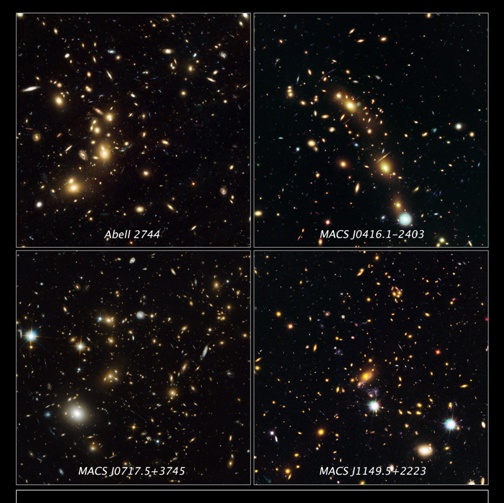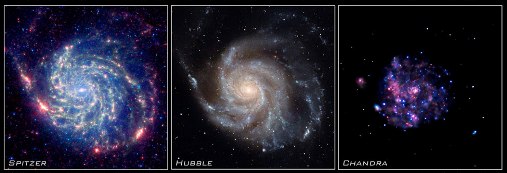 Astronomers irritate the hell out of me, NASA’s in particular, not the people but their press releases: never met a superlative they didn’t like, Biggest Black Hole, Farthest Quasar, Youngest Galaxy, and on and on, far into the night. The black hole’s size isn’t interesting unless it says something about how galaxies form. The quasar’s distance and the galaxy’s youth aren’t interesting unless they’re evidence for when and how galaxies formed. The rule is, discoveries are interesting only in their contexts. And in general press releases are less interested in context than in shock and awe, e.g., “NASA’s Great Observatories Begin Deepest Ever Probe of the Universe.” Let’s agree to ignore “deepest ever probe” and concentrate instead on those Great Observatories because NASA has a plan for using them and really, they’re good.
Astronomers irritate the hell out of me, NASA’s in particular, not the people but their press releases: never met a superlative they didn’t like, Biggest Black Hole, Farthest Quasar, Youngest Galaxy, and on and on, far into the night. The black hole’s size isn’t interesting unless it says something about how galaxies form. The quasar’s distance and the galaxy’s youth aren’t interesting unless they’re evidence for when and how galaxies formed. The rule is, discoveries are interesting only in their contexts. And in general press releases are less interested in context than in shock and awe, e.g., “NASA’s Great Observatories Begin Deepest Ever Probe of the Universe.” Let’s agree to ignore “deepest ever probe” and concentrate instead on those Great Observatories because NASA has a plan for using them and really, they’re good.
 The Great Observatories are telescopes in space, launched with great hoopla and at enormous cost in money and astronomers’ careers a long time ago. The Hubble sees in the optical wavelengths in which humans see; Chandra, in x-rays; and Spitzer, in infra-red. They’re all up there above the atmosphere that, depending on the wavelength, distorts or blocks or swamps or otherwise screws with what we can see from the ground. So they see with precision and clarity to unbelievable distances and times. The reason they’re all up there is that the optical wavelengths in which we see are a piddly, pathetic little fraction of what the universe shines in.
The Great Observatories are telescopes in space, launched with great hoopla and at enormous cost in money and astronomers’ careers a long time ago. The Hubble sees in the optical wavelengths in which humans see; Chandra, in x-rays; and Spitzer, in infra-red. They’re all up there above the atmosphere that, depending on the wavelength, distorts or blocks or swamps or otherwise screws with what we can see from the ground. So they see with precision and clarity to unbelievable distances and times. The reason they’re all up there is that the optical wavelengths in which we see are a piddly, pathetic little fraction of what the universe shines in.
The plan is called Frontier Fields (“fields” as in fields of view; “frontier” because NASA likes that word): over the next three years, all three observatories are going to look at the same few clusters of galaxies, partly because clusters themselves are interesting, partly because clusters are so massive they make big dents in space, that is, they curve the daylights out of space. And since light follows space’s curves, those big dents, those clusters, are also curving light and acting like lenses. In fact, a lens, called a gravitational lens, is real and effectively magnifies whatever is on its other side. On the other side of the clusters are galaxies going back as far as galaxies go. The lensing will show galaxies ten to a hundred times fainter and farther away, back when the universe was mostly hydrogen gas and the baby galaxies were first lighting up and blowing electrons off the hydrogen atoms and ionizing the whole universe.
The press release says that Hubble will show how fast those back-forty galaxies are forming stars. Spitzer will show how old the galaxies are. Chandra will show which of the galaxies have supermassive black holes – probably a violent youth that all galaxies go through.
The observatories will look at six clusters in all. During the first year, they’re looking at Abell 2744 and MACSJ0416.1-2403 (see photo at top of post) (the naming of astronomical things is its own rabbit hole but specifically, Abell is a catalog of bright clusters compiled by George Abell and this one is the 2,744th in that catalog; and MACS is the Massive Cluster Survey, and the numbers are the coordinates in the sky). The lensing also enables a more accurate measure of the clusters’ masses. And the amount of mass implied by the cluster galaxies’ light, compared with the amount implied by the lensing gives the amount of the clusters’ dark matter. And the amount of dark matter in the universe gives the nature of its death. (Ask Richard.)
Galaxy formation and the density of dark matter have both been studied for decades. If the Frontier Fields turn up no surprises and cosmologists continue to be right about the history of the universe, then the Great Observatories will add the refinements to cosmological history necessary for credible science. Otherwise, surprises, of course, will always be welcome. Meanwhile, what makes Frontier Fields so interesting is its multiwavelength context. The length of those waves ranges from 106 to 10-16 meters, from a million meters to a ten-quadrillionth of a meter, from radio to gamma; and the things of the universe are radiating in all of them.
The optical is the smallest band, with wavelengths right around a millionth of a meter, just a sliver of what’s out there. Looking in the optical at the universe is like hearing only the flutes in a Beethoven symphony. Granted, Spitzer and Chandra expand the range only into the infrared and xray bands, but still: looking at those fields comes a lot closer to hearing the whole orchestra.
____________
Photos:
Final Frontiers’ targeted galaxy clusters: NASA, ESA, and J. Lotz and M. Mountain (STScI)
3 images of 1 galaxy, M101: Spitzer Image: NASA, Jet Propulsion Lab/Caltech, and K. Gordon (STScI); Hubble Image: NASA, ESA, K. Kuntz (JHU), F. Bresolin (University of Hawaii), J. Trauger (Jet Propulsion Lab), J. Mould (NOAO), Y.-H. Chu (University of Illinois, Urbana), and STScI; Chandra Image: NASA, CXC, and K. Kuntz (JHU)
How little we see (and hear) is brilliantly shown by Abstruse Goose http://abstrusegoose.com/421
I do so agree: https://www.lastwordonnothing.com/2012/01/25/abstruse-goose-the-sliver-of-perception/
Thanks for the gravitational lensing educational. Here’s hoping the 3 great observatories do find some (big!) surprises.
Enjoyed your “rabbit hole” quip on
astronomical nomenclature. Is so true!
P.S. Will announce art. on my astro club’s
list serve.
Great essay Ann!
Astronomers also irritate the hell out of me too, and I am an astronomer. And yes, sometimes I irritate myself. A number of years ago, in the early days of exoplanet discovery, one PR really caught my eye. It was stated that this day will be remembered 100 years from now as the day we first discovered an exoplanet smaller than Neptune. It was described as one of the most important discoveries ever.
right.
One thing about the Frontier Fields program, is that it continues a type of public science rarely seen in astronomy. It started with the Hubble Deep Field and the vision of the director of STScI Bob WIlliams. As with all directors, he has a small amount of “discretionary” time to use or give away. Normally, the directors do not use much of this time, and they give it back to the general observing program where the telescope time is competed among all astronomers. He called for ideas. He received tremendous pressure to give the time to the “usual suspects” of famous astronomers and their groups, by these same astronomers because, after all, they are famous and such and therefore do the best science.
right.
Anyway, he called for something complete different. He decided that he was going to use ALL the time to point at a part of the sky now called the Hubble Deep Field. But instead of giving the data to the “best” astronomers, he had the STScI astronomers fully process the data, and produce data products (positions, colors, brightnesses) and the like. Then he dumped the data to the public on a pre-announced day.
Well, the results were spectacular. Instead of the usual astronomers having a lock on the data because they were awarded telescope time, money, and a proprietary period of 18 months where no one else could use the data, suddenly *everyone* had the data as the same time. It did not matter if you were from Caltech or East Jesus State University. Everyone had access to the well reduced data. Well, the number of papers from institutions all across the US and the world was tremendous. Astronomers at small institutions could compete with the larger groups, and compete they did. Of course, the larger groups had advantages and did publish many of the seminal papers, but the did not have a lock on the science anymore. It truly stimulated more science than the typical telescope time assignment.
The Frontier Fields project, is following on the HDF, the Southern HDF, and the Ultra Deep Field, in that it will also take the data, reduce the data to high level data products, and dump the data to the community.
And the race will be on.
Among many legacies of the HST, I hope that this sort of public science will not be forgotten. Sometimes the playing field really does need to be level.